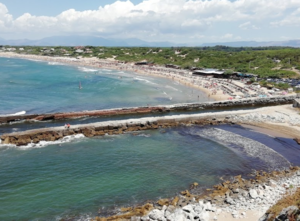
Year 216 BC was a year of the pre-Julian Roman calendar. At the time it was known as the Year of the Consulship of Varro and Paullus. The denomination 216 BC for this year has been used since the early medieval period, when the Anno Domini calendar era became the prevalent method in Europe for naming years.

Fidenae was an ancient town of Latium, situated about 8 km north of Rome on the Via Salaria. Its inhabitants were known as Fidenates. As the Tiber was the border between Etruria and Latium, the left-bank settlement of Fidenae represented an extension of Etruscan presence into Latium. The site of the arx of the ancient town was probably on the hill on which lies the contemporary Villa Spada, though no traces of early buildings or defences are to be seen; pre-Roman tombs are in the cliffs to the north. The later village lay at the foot of the hill on the eastern edge of the high-road, and its curia, with a dedicatory inscription to Marcus Aurelius by the Senatus Fidenatium, was excavated in 1889. Remains of other buildings may also be seen.

The Palatine Hill, which relative to the seven hills of Rome is the centremost, is one of the most ancient parts of the city; it has been called "the first nucleus of the Roman Empire". The site is now mainly a large open-air museum whilst the Palatine Museum houses many finds from the excavations here and from other ancient Italian sites.
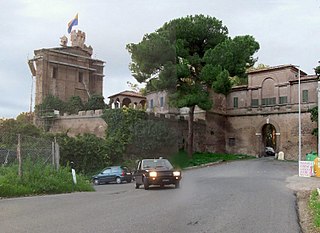
Lavinium was a port city of Latium, 6 km (3.7 mi) to the south of Rome, midway between the Tiber river at Ostia and Antium. The coastline then, as now, was a long strip of beach. Lavinium was on a hill at the southernmost edge of the Silva Laurentina, a dense laurel forest, and the northernmost edge of the Pontine Marshes, a vast malarial tract of wetlands. The basis for the port, the only one between Ostia and Antium, was evidently the mouth of the Numicus river.

Antium was an ancient coastal town in Latium, south of Rome. An oppidum was founded by people of Latial culture, then it was the main stronghold of the Volsci people until it was conquered by the Romans.

The Temple of Jupiter Optimus Maximus, also known as the Temple of Jupiter Capitolinus, was the most important temple in Ancient Rome, located on the Capitoline Hill. It was surrounded by the Area Capitolina, a precinct where numerous shrines, altars, statues and victory trophies were displayed.

Terracina is an Italian city and comune of the province of Latina, located on the coast 56 km (35 mi) southeast of Rome on the Via Appia. The site has been continuously occupied since antiquity.
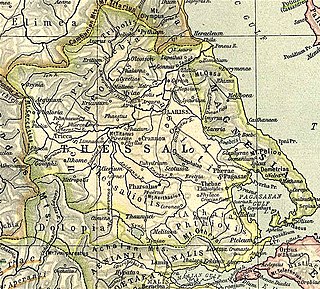
Pythion or Pythium, also Pythoion (Πύθοιον) was a city and polis (city-state) of Perrhaebia in ancient Thessaly, situated at the foot of Mount Olympus, and forming a Tripolis with the two neighbouring towns of Azorus and Doliche. Pythion derived its name from a temple of Apollo Pythius situated on one of the summits of Olympus, as we learn from an epigram of Xeinagoras, a Greek mathematician, who measured the height of Olympus from these parts. Games were also celebrated here in honour of Apollo.
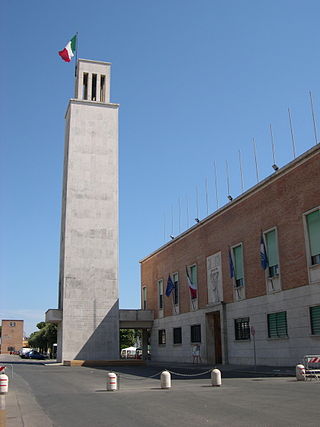
Sabaudia is a coastal town in the province of Latina, Lazio, in central Italy. Sabaudia's centre is characterised by several examples of Fascist architecture. Villa Volpi, a neoclassical seaside villa built for Countess Nathalie Volpi of Misurata, is located on the sand dunes of Sabaudia.

San Felice Circeo is a town and comune in the province of Latina, in the Lazio region of central Italy. It was an ancient city called Circeii. It is one of I Borghi più belli d'Italia.

Cori is a city and comune in the province of Latina, in the Lazio region of central Italy.
Miseno is one of the frazioni of the municipality of Bacoli in the Italian Province of Naples. Known in ancient Roman times as Misenum, it is the site of a great Roman port.

Alba Longa was an ancient Latin city in Central Italy in the vicinity of Lake Albano in the Alban Hills. The ancient Romans believed it to be the founder and head of the Latin League, before it was destroyed by the Roman Kingdom around the middle of the 7th century BC and its inhabitants were forced to settle in Rome. In legend, Romulus and Remus, founders of Rome, had come from the royal dynasty of Alba Longa, which in Virgil's Aeneid had been the bloodline of Aeneas, a son of Venus.

Horreum or Orraon or Horraon was a Greek city of ancient Epirus. Orraon is located on a hill by the Amvrakikos Gulf which is located in Northwestern Greece, to the west of Ammotopos. It guards the passage all the way down to the Ioannina Basin.
Daedala or Daidala was a city of the Rhodian Peraea in ancient Caria, or a small place, as Stephanus of Byzantium says, on the authority of Strabo.

Circeo National Park is an Italian national park founded in 1934. It occupies a strip of coastal land from Anzio to Terracina, including also a sector of forest in the mainland of San Felice Circeo, and the island of Zannone.

The Temple of Isis and Serapis was a double temple in Rome dedicated to the Egyptian deities Isis and Serapis on the Campus Martius, directly to the east of the Saepta Julia. The temple to Isis, the Iseum Campense, stood across a plaza from the Serapeum dedicated to Serapis. The remains of the Temple of Serapis now lie under the church of Santo Stefano del Cacco, and the Temple of Isis lay north of it, just east of Santa Maria sopra Minerva. Both temples were made up of a combination of Egyptian and Hellenistic architectural styles. Much of the artwork decorating the temples used motifs evoking Egypt, and they contained several genuinely Egyptian objects, such as couples of obelisks in red or pink granite from Syene.
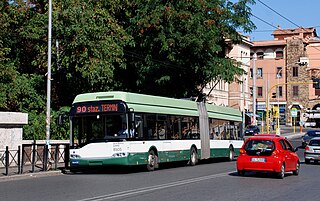
Municipio Roma III is the third administrative subdivision of Rome (Italy).

The ancient Roman Villa of Domitian is located on the shore of the lagoon of Paola between Sabaudia and San Felice Circeo, at a locality known as Palazzo. It was one of the palaces that belonged to the emperor Domitian, and which he called his villa "at Circeii". It is considered one of the most important yet little-known Roman imperial residences in Latium.
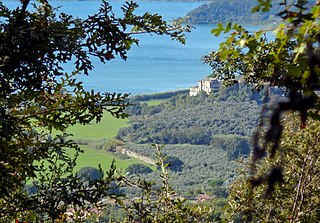
The Imperial Villa of Vicarello was an ancient Roman villa-estate that belonged to the emperors starting from Domitian (r.81-96). It is situated near the north shore of Lake Bracciano and near the village of Vicarello, near the modern town of Trevignano Romano. The current private Vicarello estate is a park of about 2000 hectares in which the Roman remains of the villa and associated monumental baths were discovered in the 19th century, some of which are still preserved. The two main ancient centres are:





